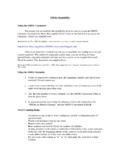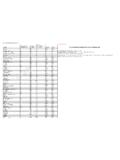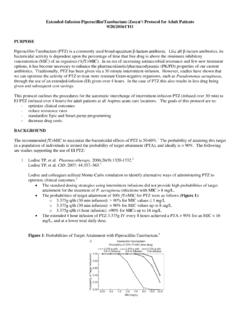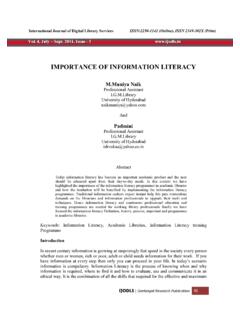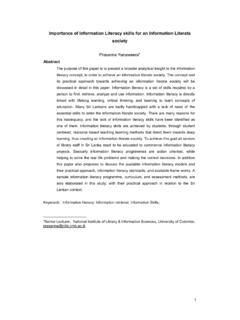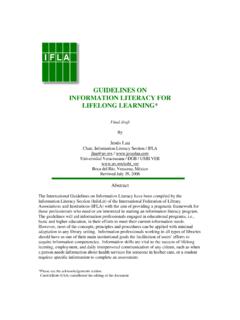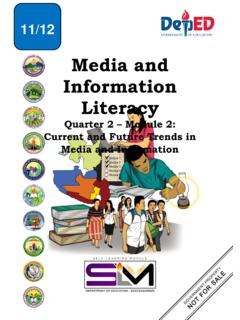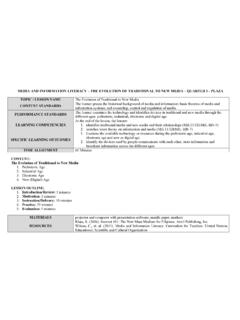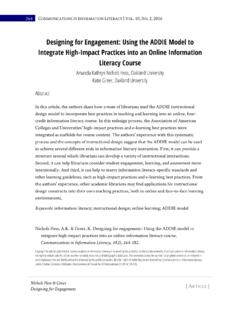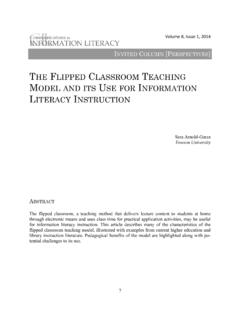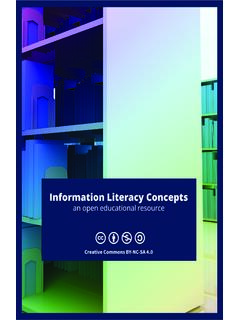Transcription of SAM Suitability Assessment of Materials - Information Links
1 Content Purpose SAM, the Suitability Assessment of Materials instrument offers a systematic method to objec-tively assess the Suitability of health Information Materials for a particular audience in a short time. How it works SAM guides you to rate Materials on factors that affect readability (the relative difficulty of decoding the words) and comprehension (the relative difficulty of understanding the mean-ing). SAM rates Materials in these six areas Content literacy Demand Graphics Layout and Type Learning Stimulation & Motivation Cultural Appropriateness Easy Scoring For each factor, rate the Materials Superior, Ade-quate or Not Suitable based on objective criteria included in the instrument. You can calculate a score for each area and overall. For a panel of reviewers, you might average the ratings. Score the Materials by assigning points as follows. Superior ~ 2 points Adequate ~ 1 Not Suitable ~ 0 Use SAM to: Measure how well Materials fit your clients Compare different Materials and select those most suitable for your clients Tailor existing Materials for a particular population Guide development and testing of cul-turally and linguistically appropriate ma-terials Set standards Clients have the last word SAM is an at-your-desk review.
2 It can help you save time and money and improve program ef-fectiveness by selecting or producing Materials that your clients are likely to pick up, read ,understand and act on. SAM cannot sub-stitute for formative research and testing through which clients verify that the informa-tion is attractive, useful and persuasive to them. About the Instrument SAM was developed in 1993 by Leonard and Cecilia Doak and Jane Root, leading experts in health education for adults, under the Johns Hopkins School of Medicine project, Nutrition for Education in Urban African Americans funded by the National Institutes of Health. Validation was conducted with 172 health care providers from several cultures as well as students and faculty of the University of North Carolina School of Public Health and Johns Hopkins School of Medicine. For more detail see Doak C, Doak L, and Root J. Teaching Patients with Low literacy Skills, 2nd Edition, Philadelphia: Lipincott 1996. SAM Suitability Assessment of Materials for evaluation of health-related Information for adults 2008.
3 Practice Development, Inc. All rights reserved. Written permission required for all manner of duplication. 2008. Practice Development, Inc. All rights reserved. Written permission required for all manner of duplication. 2 Instructions for Evaluating Beginnings Guides with SAM 1. Read through the SAM instrument on the following pages to get a sense of the evaluation criteria. 2. Read all the way through the titles you are considering for your program. You will find the Beginnings Pregnancy and Parent s Guides are easy to read. As you read the Beginnings Materials , keep in mind that the Materials are distributed one booklet at a time through the course of their pregnancy and/or the child s first three years. Typically there will be several weeks time between booklets. You may choose to apply SAM to the entire series or choose one booklet. 3. Use the SAM form provided here to rate the Materials . For each factor, check the box that best describes your rating.
4 Choose Superior, Adequate or Not Suitable. Write comments in the space provided, in the margins, on the back. Comments can be very useful to the decision makers for your material requisitions requests. Questions & Assistance Please call me with questions about your review of the Beginnings Guides or use of the SAM instrument. Sandra Smith, MPH, CHES Beginnings Guides Editor 2821 Second Ave Suite 1601 Seattle WA 98121 800-444-8806 Please share your results with us. Your feedback will help us continue to improve the Guides. Fax to: 206-728-1926 SAM Suitability Assessment of Materials adapted with permission from Doak, Doak, Root 1996 Content Purpose: It is important that readers readily understand the purpose of the Materials . If they don t clearly perceive the purpose, they may miss main points. Check One: Superior: Purpose is explicitly stated in the title, cover illustration or introduction. Adequate Purpose is not explicit. It is implied or multiple purposes are stated.
5 Not Suitable No purpose is stated in the title, illustration or introduction. Comment: Content Topics: Adult learners usually want to solve their immediate health problem, rather than learn medical facts. The content of most interest and use to readers is behavior Information that helps solve problems. Check One: Superior: Thrust of the material is application of knowledge aimed at desirable reader behavior. Adequate At least 40% of content topics focus on desirable behaviors or actions. Not Suitable Nearly all topics focus on non-behavior facts. Comment: Summary & Review: A review offers readers a chance to see the key points in other words, examples or visuals and increases comprehension. Check One: Superior: Summaries are included and retell key messages in different words or examples. Adequate Some key topics are reviewed. Not Suitable No summary or review is included. Comment: SAM Suitability Assessment of Materials adapted with permission from Doak, Doak, Root 1996 2008.
6 Practice Development, Inc. All rights reserved. Written permission required for all manner of duplication. 3 SAM Suitability Assessment of Materials adapted with permission from Doak, Doak, Root 1996 literacy Demand Reading Grade Level: Text reading level is a critical factor in comprehension. Readability formulas provide a reasonably accurate measure of reading difficulty. Beginnings reading level is 4th grade throughout measured by the Flesch-Kincaid formula. It measures on the Flesch Reading Ease scale. For detail see Check One: Superior: 5th grade or level or lower Adequate 6th to 8th grade Not Suitable 9th grade or above Comment Writing Style: Conversational style and active voice are easy to understand. Passive voice, embedded Information and long or multiple phrases slow reading and reduce comprehension. Example: Take your vitamin every day is easier to understand than Patients are advised to take their vitamin daily. Check One: Superior: 1)Conversational style and active voice are used throughout.
7 2)Simple sentences are used extensively. Adequate 1)About half the text uses conversational style, active voice. 2) Less than half of sentences are complex with long phrases. Not Suitable 1) Passive voice throughout. 2) Over half of sentence have long or multiple phrases. Comment Sentence Construction: The context is given before new Information . We learn new facts/behaviors more quickly when told the context first. Example: To relieve pain (context), put heat on the sore spot (new Information ). Check One: Superior: Consistently provides context before presenting new Information . Adequate Provides context first about half the time. Not Suitable Context is provided first or not at all. Comment 2008. Practice Development, Inc. All rights reserved. Written permission required for all manner of duplication. 4 Vocabulary: Common explicit words are used. (Example: Use doctor instead of physician). Few or no words express general terms such as categories (Example: Use milk instead of dairy products) or value judgments (Example: Use pain that does not go away in 5 minutes instead of excessive pain).
8 Imagery words are used because these are words that people can see . (Example:Use runny nose instead of excess mucus). Check One: Superior: All three factors: 1) common words are used all the time. 2) Technical, concept, category, value judgment words (CCVJ) are explained. 3) Appropriate imagery words are used. Adequate 1) Common words are used frequently. 2. Technical CCVJ words are explained sometimes. 3. Some jargon is used. Not Suitable 1) Two or more factors: 1) Uncommon words are used frequently instead of common words. 2) No explanation or examples are given for technical and CCVJ words. 3) Extensive jargon. Comment Learning Enhanced by Advance Organizers (Road Signs): Headers or topic captions tell very briefly what is coming next. These road signs make the text look less intimidating and prepare the reader s thought process to expect the announced topic. Check One: Superior: Nearly all topics are preceded by an advance organizer (a statement that tells what is next).
9 Adequate About 50% of topics are preceded by advance organizers. Not Suitable Few or no advance organizers are used. Comment SAM Suitability Assessment of Materials adapted with permission from Doak, Doak, Root 1996 2008. Practice Development, Inc. All rights reserved. Written permission required for all manner of duplication. 5 Graphic Illustrations, Lists, Tables, Charts Cover Graphic: People do judge a book by its cover. The cover image often is the deciding factor in a reader s attitude toward, and interest in, the Materials . Check One: Superior: The cover graphic: 1) Is friendly 2) Attracts attention. 3) Clearly portrays the purpose of the Materials Adequate The cover graphic has one or two of the superior criteria. Not Suitable The cover graphic has none of the superior criteria. Comment Type of Illustrations: Simple line drawings can promote realism without distracting details. Visuals are accepted and remembered better when they portray what is familiar and easily recognized.
10 Viewers may not recognize the meaning of medical drawings or abstract symbols. Check One: Superior: Both factors: 1) Simple adult-appropriate line drawings/sketches are used. 2) Illustrations are likely to be familiar to readers Adequate One of the superior factors is missing. Not Suitable None of the superior factors is present. Comment Relevance of Illustrations: Nonessential details such as room backgrounds, elaborate borders, unneeded color can distract the viewer. The viewer s eyes may be captured by these details. Illustrations should tell key points visibly. Check One: Superior: Illustrations present key messages visually so the reader can grasp the key ideas from illustrations alone. No distractions. Adequate 1) Illustrations include some distractions. 2) Insufficient use of illustrations. Not Suitable No illustrations or an overload of illustrations. Comment SAM Suitability Assessment of Materials adapted with permission from Doak, Doak, Root 1996 2008.

